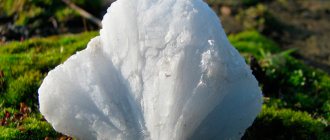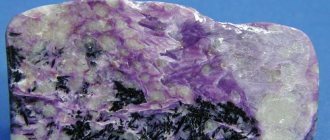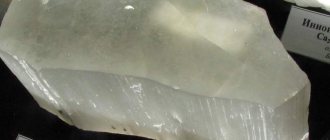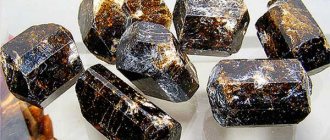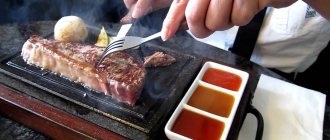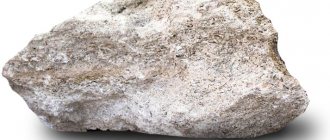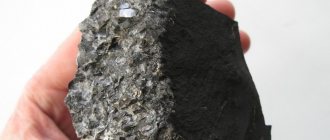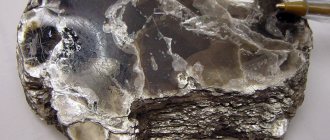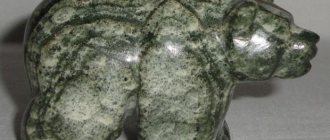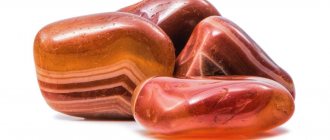The chrysocolla stone, which has many synonymous names (it is called copper malachite, golden glue, green spar and psilomelane), is an obligatory companion of any copper deposit.
Being a mineral of the water element and symbolizing the maternal and feminine principles, the gem magically transforms every representative of the fair sex who owns it.
A polished chrysocolla ball is strikingly similar to a miniature globe - a three-dimensional model of our planet: blue and green stains on the surface of the stone form a pattern reminiscent of the contours of oceans and continents.
You can look at the play of its colors endlessly: this activity is mesmerizing.
What is this stone?
Photo:
Chrysocolla, a silicate mineral, is a hydrous silicate of copper, which gives the stone a bluish-green or bright blue color.
Chrysocolla in the form of dense cluster-shaped aggregates is found in the upper layers of copper veins in mines scattered across different parts of the globe.
The appearance and chemical composition of the mineral - depending on the amount of impurities and impurities - is extremely variable.
For this reason, chrysocolla is often confused with other minerals of similar colors, mistaking it for blue chalcedony, variscite and turquoise.
Mineral deposits
Chrysocolla is born in mine and opal deposits and is a lumpy formation - a crust. Its deposits are found all over the globe; the largest production is carried out in:
- Eilat is a city in southern Israel. The history of this deposit dates back to the time of King Solomon.
- Andah.
- Mexico.
- The states of Arizona and Nevada in the USA.
- Germany.
- Australia.
- Brazil.
- Kazakhstan.
- Peru.
- Chile.
- Russia (Turinsky mines, Transbaikalia, Ural).
Usage history
The ancient Greek naturalist and philosopher Theophrastus, who lived in the 4th century. dn. BC, discovered copper in the composition of the mineral and invented a method for melting it, which made it possible to use the gem as copper solder in the manufacture of gold jewelry.
He named the mineral chrysocolla (or “golden glue”, translated from ancient Greek).
The discoverers of this beautiful gem were the inhabitants of ancient Egypt.
They actively used stone in various areas of their lives:
- The mineral, ground into powder and mixed with olive oil , was used as eye shadow by both women and men. This natural cosmetic product not only emphasized the beauty of the eyes, but also prevented premature aging of the skin.
- The same powder, mixed with water , was used to produce surprisingly bright and durable mineral paints (green, blue and dark blue), which were used to paint dishes and walls of burial chambers in the pyramids of the pharaohs, and to perform palace paintings and temple frescoes. Drawings made with chrysocolla paints have not lost their brightness to this day.
- Chrysocolla, along with lapis lazuli and malachite, was used as raw material in copper smelting.
- with chrysocolla slabs , and from their fragments they created wonderful mosaic panels.
- The beautiful stone was used to make jewelry , which, in particular, was owned by Cleopatra herself.
According to legend, it was chrysocolla that made the Jewish king Solomon fabulously rich. Its famous mines, mentioned in the Bible, were located in the vicinity of the city of Eilat, located on the shores of the Red Sea.
The extraction and sale of “Eilat” stone, highly valued by residents of countries neighboring Judea, significantly enriched the state treasury.
By order of the legendary king, the floors and walls of the first Jerusalem temple were decorated with chrysocolla slabs.
Legend has it that Solomon never parted with a ring decorated with a magnificent chrysocolla, which endowed him with boundless wisdom.
Paying tribute to the legend, chrysocolla began to be called the stone of King Solomon. (This is interesting: there is also a Pentacle of Solomon).
During the Renaissance, mineral paints made from chrysocolla were used by artists and icon painters.
Chrysocolla - properties and meaning
Chrysocolla stone is one of the most mysterious minerals, the properties of which, origin, chemical composition and species have not been fully studied.
Chrysocolla is one of the most ancient gems. Scientists have found numerous evidence of its use by ancient peoples.
The inhabitants of Ancient Egypt made a special blue and green paint - frit - from a mixture of chrysocolla and malachite. This paint was used to create wall frescoes that decorated pyramids and ancient temples, paintings on dishes, and drawings on jewelry. And Egyptian women used frit for cosmetic purposes - as beautiful blue, green and light blue eye shadow.
Chrysocolla was also used by the Egyptians to make unique mosaic tiles. The richness of its color opened up great opportunities for the implementation of creative ideas.
The peoples of the Andes, who inhabited this territory even before the Incas, used chrysocolla as a jewelry and ornamental stone. These traditions have been preserved to this day. And today, jewelers and artisans from South America make figurines, beads, cabochons for rings and earrings from this stone. Residents of Peru encrusted gold jewelry with chrysocolla. Such jewelry was found in numerous burials discovered among the ruins of the ancient city of Kantur-Uassi, which flourished in the 1st millennium BC. But the main area of application of chrysocolla in ancient times was the soldering of gold products. This fragile and light rock was used as gold solder or “gold glue”. Hence the name of the stone - chrysocolla, consisting of two words: “chrysos” (“χρυσός”) and “kolla” (“κόλλα”), which are translated from Greek as “gold” and “glue”. This name was given to the mineral by Theophrastus (the famous ancient Greek scientist) in Art. BC e.
Externally, chrysocolla is very reminiscent of turquoise, malachite and azurite; it is not without reason that it is often confused with these minerals, especially since chrysocolla literally “grows together” with them. However, despite the external similarity, it is a completely different stone, with different properties and chemical composition.
It is a light, opaque mineral with a waxy or glassy luster of blue-green color. Most often, specimens of chrysocolla are found in a pleasant sky blue, blue or greenish-blue color, but sometimes specimens of a brownish tint are also found. Different peoples called this unusual stone and its varieties differently: mountain green, demidovite, copper green, golden glue, copper malachite. But perhaps the most unusual and beautiful name for chrysocolla is Elat or Eilat stone, which it received from the name of the Israeli city of Eilat, located near the Gulf of Eilat of the same name, where it was mined in ancient times.
Healing properties of the mineral:
The most effective healing properties of chrysocolla, according to lithotherapists, are for the treatment of female diseases.
It is used for acute menstrual pain, menstrual irregularities, ovarian dysfunction, and inflammation of the female genital organs.
Traditional healers attribute to this mineral the ability to help with diseases such as bronchitis, colds, throat diseases, chronic cough, thyroid dysfunction.
The effect of chrysocolla on a person’s psycho-emotional state is considered beneficial. In particular, it is recommended to wear it for: nervous exhaustion, insomnia, apathy, depression, depression.
Magic properties:
Chrysocolla is considered a feminine stone, so its magical influence on women is especially great. This amazing mineral, thanks to its magical properties, can help a woman reveal her inner world and better understand the surrounding reality. Chrysocolla makes its owner refined, gentle and feminine, develops maternal feelings and kindness in her. It is not for nothing that ancient magicians advised husbands to give chrysocolla jewelry as a gift to their wives in order to develop in them the feminine principle and the best spiritual qualities. In addition, very powerful amulets and amulets were made from chrysocolla to protect against temptations and fears, dark forces and evil spirits.
Chrysocolla and zodiac signs:
According to astrologers, chrysocolla and products made from it are most suitable for Taurus and Sagittarius. Thanks to this stone, people born under the signs of Sagittarius and Taurus can gain wisdom and develop their intuition. Wearing amulets and jewelry with chrysocolla also has a beneficial effect on people born under the signs: Libra, Leo, Aquarius, Cancer.
Application of the gem:
Chrysocolla is of particular interest to collectors and is also used for making: jewelry, decorative elements, and souvenirs.
Interesting facts about the stone:
The name of such a famous biblical hero as King Solomon is associated with chrysocolla. There is an opinion that it was thanks to this amazing stone that Solomon received all his wealth. Elat stone, as chrysocolla was then called, was highly valued during the reign of the biblical king and helped him turn his country into a powerful state.
How to distinguish natural chrysocolla from a fake:
There is a fairly simple and reliable way to determine the naturalness of chrysocolla. There is no need to carry out special analyzes or experiments; just touch the stone with the tip of your tongue. Natural chrysocolla, being a hydrous silicate of aluminum and copper, literally sticks to the tongue. Moreover, the degree of its “sticking” depends on its saturation with water: the lower the water content in the stone, the more it sticks to the tongue.
Chemical composition and physical properties:
According to its chemical composition, chrysocolla is a complex hydrous silicate of copper and aluminum. In addition, chrysocolla may contain impurities that change its density, color, and the very structure of the gem. The high copper content gives chrysocolla a beautiful turquoise color, and the combination of copper, aluminum and iron gives the mineral a green tint. Thanks to the admixtures of kaolinite, heavenly-colored chrysocolla is formed, and the presence of manganese gives the mineral a brown tint. Depending on its structure, chrysocolla can be very fragile and soft, or it can be denser and harder. In denser and harder specimens you can see a glassy, waxy sheen, which is absent in less dense varieties.
There are the following main varieties of chrysocolla:
Asperolite is a bluish-green chrysocolla that forms in the form of fragile kidney-shaped masses. It is a high water content variety of chrysocolla.
Bisbyite is a blue chrysocolla. It is a low water content variety of chrysocolla.
Demidovite is a dense chrysocolla of sky blue, blue or greenish color, formed in the form of thin covers - crusts of the mineral on malachite. This is one of the most expensive varieties of chrysocolla, a good jewelry and semi-precious stone, often used to imitate turquoise.
There are varieties of chrysocolla based on their deposits: Mexican chrysocolla; Arizona chrysocolla; chrysocolla peruviana.
Place of Birth:
The main deposits of chrysocolla are located in Russia (in the Turinsky mines), Kazakhstan, the USA, Chile, Peru and Zaire.
Care:
Chrysocolla is a very fragile stone and requires special attention and care. This stone should be protected from: sudden changes in temperature, heat, exposure to acids, shock, exposure to abrasives and fumes, contact with other stones, prolonged exposure to water. Chrysocolla cannot be cleaned with ultrasound, steam, or even soapy water. You should also not wash chrysocolla in water, because... water can affect its color and structure. It is enough to sometimes wipe the stone with a soft flannel, suede or woolen cloth.
Chrysocolla bracelet can be purchased here:
Meaning
Today, chrysocolla is most often used as:
- Jewelry and ornamental stone , ideal for making jewelry (pendants, earrings, bracelets, beads and rings), magical items (talismans, amulets and amulets);
- Small plastics (all kinds of figures, figurines and balls).
A malleable mineral that lends itself well to polishing, with proper care it remains smooth and shiny for a long time, and the variety of colors allows it to be set in gold, silver and costume jewelry alloys.
Rare varieties of the mineral, similar to turquoise and valued no less than precious stones, are of particular importance to collectors who replenish their collections with untreated specimens, cabochons or tumbling.
Application
The chrysocolla mineral is used mainly as an ornamental and collection material. Rare specimens are considered precious stones and are used by jewelers.
This mineral is easy to process and, with proper care, retains its smoothness and shine.
Thanks to the variety of colors of the stone, jewelry with it looks beautiful in a frame made of silver, platinum and other metals.
An assortment of chrysocolla jewelry: earrings, rings, beads, pendants, etc. Each piece of this stone is unique. Even if the inserts are in paired products, they are at least slightly different from each other.
Stone carvers make small sculptures: figurines, balls, and other popular products.
Tumbling, cabochons, and untreated samples are purchased by collectors. They pay a lot of money for specimens with unusual designs and interesting color combinations.
Physical properties
The mineral is characterized by:
- Small (within 2.0-2.2) specific gravity.
- Density equal to 2.1 g/cm3.
- Instability of optical data due to the opacity of the stone.
- Lack of luminescence, dispersion and birefringence.
- Inability to interpret the absorption spectrum.
- Weak pleochroism.
- Hardness, which - depending on the characteristics of the chemical composition - can range from 2-4 points on the Mohs scale (for example, a sample containing silica particles can scratch glass).
- Conchoidal fracture.
- Rhombic system.
- Lack of cleavage.
- Glassy, greasy or waxy sheen.
- A rich range of colors, the diversity of which is due to the presence of impurities. The copper content colors the stone in turquoise tones. The combination of iron, aluminum and copper gives the mineral a golden color, and the tandem of aluminum and iron gives it a green color. Impurities of kaolinite color chrysocolla in sky-blue tones, and the high content of manganese makes its color brown.
The physical properties and chemical composition of chrysocolla are variable, since under the influence of environmental factors the percentage of its main components periodically changes (in some cases quite significantly).
Depending on this, the density, color and even structure of the mineral may change.
Chrysocolla specimens can be dense and hard or brittle and soft. Dense aggregates have a waxy, glassy luster, which gradually disappears as the mineral softens.
About the physics and chemistry of chrysocolla
The mineral chrysocolla is the child of copper. Formed due to the decomposition of copper ores.
- siliceous malachite;
- copper blue;
- copper silica;
- copper greens.
Any of these names corresponds to chrysocolla. The stone is not found in the form of crystals, only in solid masses.
The chemical formula of the mineral is (Cu, Al)2H2Si2O5(OH)4.nH2O. It is a complex silicate of copper and aluminum.
Copper content 16-75%, silicic acid from 10 to 67%.
Physical properties of chrysocolla:
- color blue, green, dark blue, sea green;
- hardness 2-4 on the Mohs scale;
- greasy, waxy, glassy luster;
- opaque.
| Color | Green or blue, in the presence of iron and copper oxides the color changes to brown and black |
| Stroke color | White |
| Chemical formula | (Cu, Al)2H2Si2O5(OH)4 • p H2O |
| Shine | glass wax |
| Transparency | shines through |
| Kink | conchoidal |
| Hardness | 2 2,5 |
| Selection form | not described |
| Classes on taxonomy of the USSR | Silicates |
| singonia | monoclinic |
| Additionally | Color and appearance. Green Chrysocolla is similar to malachite, but when exposed to HC1, bubbles do not appear. |
Due to the variability of appearance, the mineral can easily be confused with blue chalcedony, turquoise, or variscite.
Place of Birth
The mineral that forms in copper strata and is mined along with it is not rare. Its rich deposits are found on all continents of our planet.
Chrysocolla mining is established in:
- North and South America (gemologists accurately divide chrysocolla into Peruvian, Mexican and Arizona);
- Europe (Czech Republic and Germany);
- Australia;
- Africa (in Congo and Zaire);
- Kazakhstan;
- Israel.
Chrysocolla vein
In Russia, there are deposits of chrysocolla in Transbaikalia, Altai and the Urals. The Mednorudyanka quarry, located almost in the center of Nizhny Tagil, claims - along with the Arizona quarry - to be the largest chrysocolla deposit.
At the Mednorudyansky quarry and in the Turinsky mines, located in the vicinity of Krasnoturinsk (Sverdlovsk region), demidovite is mined - the most expensive variety of chrysocolla, colored sky blue.
When extracting chrysocolla, which begins to crumble and lose its decorative effect when exposed to high pressure or sudden temperature changes, it is recommended to be very careful.
It is the difficulties that complicate the extraction of semi-precious stone that are the reason for its rather high cost.
Copper mines are a source of chrysocolla
The gem is found wherever copper was (or is) mined.
There are deposits very rich in the mineral:
- Kupferberg (Bavaria);
- Schneeberg (Saxony);
- Kupferberg (Silesia);
- Starkenbach (Bohemia);
- Cornwallis;
- Arizona, Nevada (America);
- Peru;
- Chile.
In Russia, sky-blue chrysocolla is found in the Turinsky mines (Bogoslovsk) in Altai, in the Zmeinogorsky and Zolotushinsky mines.
There are several varieties of chrysocolla known:
- Asperolite. It is found in the Mednorudyansky mine (Nizhny Tagil), a beautiful mineral of bluish-green color, fragile, crumbling into powder in water;
- Pilarite - high alumina content.
- Demidovit. Formed on kidney-shaped malachites. Blue chrysocolla, blue, greenish - very beautiful stones, similar to turquoise.
- Catangitis. Dark green, glassy variety. Named after its location (Katango, Congo).
- Eilat stone . Gemologists have different views on the stone. Some believe that it is a mixture of azurite and malachite. Others say that this is the result of the fusion of malachite, turquoise and chrysoccola.
The colors of chrysocolla depend on the amount of impurities. Manganese inclusions turn brown. The more copper, the more “turquoise” the color of the stone. Green appears with certain combinations of copper, aluminum and iron.
Varieties
The color, transparency and luster of different varieties of chrysocolla differ radically.
The chemical composition of crystals is so diverse that it allows gemologists to identify at least a dozen varieties of the mineral, but we will talk in more detail about several main ones.
Asperolite
An opaque mineral, colored greenish-blue, with many black and white specks.
The high water content gives it extraordinary fragility.
The presence of a characteristic oily sheen, a clear pattern and a relatively smooth surface are among the distinctive features of asperolite.
Biisbit
The mineral is pale blue or dark blue in color, endowed with a ribbed structure that can be easily processed (jewelers and stone cutters love it for this quality) and decorated with patterns in green, brown, white, red and yellow tones.
Due to its minimal water content, bisbit is a very dense and matte variety of chrysocolla, with absolutely no shine.
Demidovit
A brilliant mineral of extraordinary beauty, painted in different shades of sky blue, found in the Northern Urals, bears the name of the Russian entrepreneur A. N. Demidov.
Having a coarse grained structure, this stone, formed as a result of the adhesion of bluish-green crusts of chrysocolla to blocks of malachite, is its strongest, densest and most expensive variety.
Collectors classify individual translucent specimens of demidovite as precious stones.
The similarity of demidovite with turquoise is the reason for its high demand among jewelers around the world.
Copper glaze (azurite)
A mixture of lapis lazuli and chrysocolla. A fragile blue compound with numerous inclusions. It is formed in the form of crystals and has perfect cleavage.
Eilat stone
Chrysocolla + turquoise + malachite.
Varieties and colors
The stone is usually opaque, but some varieties can be translucent. The surface of hard rocks is shiny and enamel-like, while the very fragile mineral chrysocolla is almost matte. The cut shows multiple veins and inclusions that form a heterogeneous, beautiful pattern.
In addition to green and blue shades, the following stone colors are found in nature: turquoise, blue, brown and even black. This indicator is influenced by the content of elements in the composition. Silicate with a high concentration of copper will be blue or cyan, aluminum will add a green tint, red-brown inclusions appear from the presence of manganese, and black ones due to iron.
The most common varieties of chrysocolla are called:
- asperolite - green-blue, with a high moisture content and therefore fragile;
Asperolite - bisbyite — the mineral is characterized by a blue color, the concentration of water in it is minimal;
Bisbeit - demidovid Thanks to its dark green and blue shades, it looks like turquoise. The structure is denser and stronger than the above.
Demidovid
Magic properties
The variability of the mineral is often compared with the unpredictability of female nature, and its magic, which has a beneficial effect on the fair sex, is called feminine.
The magical properties of chrysocolla help them:
- Develop maternal instinct (the influence of the stone will make even a convinced supporter of the childfree movement think about the need for motherhood);
- Find a reliable life partner;
- Get rid of all kinds of phobias;
- Find protection from external negativity and unwanted temptations;
- Identify and reveal previously unknown abilities.
Chrysocolla, endowed with the ability to absorb negative energy directed at its owner, plays the role of a lightning rod and does not allow troubles to befall him.
The mineral, considered the favorite stone of King Solomon, makes its owners smarter and more reasonable. A pebble lying in the pocket of a schoolchild or student will help him successfully cope with any educational task.
How to care for chrysocolla
Whatever the purpose of using jewelry containing chrysocolla, it should definitely be stored carefully and the stone should be carefully cared for. By nature, the mineral is fragile, it reacts very actively to contact with all kinds of substances, and is quite sensitive to mechanical damage and temperature changes.
To clean the nugget, you need to carefully wipe it, using only a dry cloth made of soft and delicate fabric. After light polishing, the gem will acquire a glass or waxy luster.
Medicinal properties
The healing properties of chrysocolla allow it to be used to treat:
- Alcohol addiction , however, the help of the stone will be effective only if the person himself wants to get rid of alcoholism. Constantly wearing a bracelet or ring with this stone will help speed up getting a positive result.
- Gynecological problems (inflammation of the female reproductive organs, menstrual irregularities, hormonal imbalances).
- Infertility.
- Diseases of the upper respiratory tract (colds, bronchitis, sore throat, etc.). Beads or a pendant made of chrysocolla will ease the production of sputum, stop attacks of suffocation and speed up the patient’s recovery.
- Chronic diseases of the gastrointestinal tract. Wearing bracelets, beads and rings promotes rapid restoration of the mucous membrane and scarring of gastric ulcers.
- Mental disorders (apathy, depression, sleep disorders).
- Neglected wounds. By rolling a pebble around their edges, you can stop bleeding, speed up the regeneration of affected tissues and slow down inflammatory processes.
- Pain syndrome. A stone applied to the problem area normalizes the patient's condition within 2-3 minutes.
Scope and scope
It is known that from ancient times the Egyptians used this stone as a finishing material and raw material for creating durable, rich colors that covered the facades of buildings, interior items and decorative items, and the Egyptians used the powdered stone as eye shadow, mixing it with fatty creams. Nefertiti herself was an ardent fan of cosmetics made with chrysocolla, as evidenced by the images of the queen with eyes painted with bright emerald shadows that have survived to this day.
The durability of paints made using gold glue is amazing, because samples of household items painted with it have survived to this day and have not lost their richness.
Today, chrysocolla is no less popular: this mineral occupies a separate place among ornamental stones; in addition, even the ancient technology for making the thinnest plates for mosaics, which is used in decorative and applied arts to this day, has been preserved.
The mineral has not found any other practical application for industrial purposes.
Zodiac sign
In accordance with astrological tables, we can conclude that the stone is contraindicated for only a few signs of the Zodiac: Gemini and Aries.
| Zodiac sign | “+++” — recommended constantly “++” — positive influence “+” — neutral “-” — negative |
| Taurus | +++ |
| Sagittarius | +++ |
| Cancers | ++ |
| Aquarius | ++ |
| Scales | ++ |
| Lions | ++ |
| Fish | + |
| Scorpios | + |
| Virgo | + |
| Capricorns | + |
| Aries | — |
| Twins | — |
Medicinal properties
Chrysocolla is suitable as a lithotherapeutic mineral for both adults and children. It is known that it has a positive effect not only on the physical, but also on the mental health of a person. Its ability to cope with psychological dependencies, fears and anxieties is especially useful.
Since ancient times, the mineral has been used as a healing stone for people suffering from severe alcohol or nicotine addiction. Amulets containing the mineral will easily help a person suffering from so-called “domestic drunkenness” to such an extent that he will forget about alcohol forever. Many sources indicate that the nugget has been used as a treatment for drunkenness for a very long time - since the times of ancient Rome, then healers gave heavy alcoholics a solution of powdered chrysocolla stone, and the disease disappeared without a trace.
In addition, the stone is able to quickly restore the body, completely relieving a person of any consequences of prolonged drunkenness.
It would also be a good idea for smokers to have a talisman with an Eilat stone - since it has become famous among lithotherapists as a mineral that removes toxins and poisonous substances. It is even possible to completely get rid of addiction with constant contact with such an amulet.
It will also be an excellent assistant for women and men suffering from problems with reproductive function. It helps restore dysfunction of the reproductive system, eliminates the symptoms and causes of infertility. For women who have recently given birth to a child, the mineral will help quickly restore proper functioning of hormonal levels, as well as put in order their mental state, which is subject to constant stress. For girls, the gem helps relieve pain during premenstrual syndrome.
People who complain of problems with the gastrointestinal tract should also pay attention to this amazing gem. It fights problems such as ulcers, gastritis, high acidity, enzyme deficiency, etc.
It is also recommended as jewelry and amulets for those who suffer from ailments such as:
- Anxiety;
- Increased excitability;
- Nightmares;
- Migraine;
- Apathy and depression;
- Insomnia;
- Bronchitis;
- Asthma;
- Angina and others
For children, the stone helps overcome pathological fears, for example: fear of the dark, nightmares, as well as fears and complexes associated with age-related changes: fear of success, stage fright, fear of ridicule, etc.
Magic properties
Since chrysocolla is primarily a stone against alcoholism, it is actively used as an amulet in ceremonies and rituals associated with getting rid of this disease. Being a powerful amulet, it will save the patient not only from the disease itself, but also from the disastrous consequences that lead to changes both in the body and in various areas of life.
Using such a magical property of a gem as dispelling an evil spirit, many magicians and shamans feel safe, since the mineral will not only protect from the negative effects of an aggressive spirit, but will also help get rid of the consequences of evil spells cast earlier.
It will help people associated with intellectual activity in maintaining thoughts and ideas in the right direction, it will give students energy and activate internal resources, and it will help schoolchildren to concentrate.
Eilat stone has a particularly beneficial effect on women. A girl who wears such an amulet not for show gains grace, exudes feminine strength and attracts the attention of men.
Decorations
Since the name of the mineral is directly related to such a precious metal as gold, it is considered an unspoken rule to set chrysocolla crystals in it. This fact significantly increases the cost of the product on the jewelry market.
The price of the product depends both on the high cost of the metal in which the stone is set, and on the cutting method, the “purity” of the stone, its weight, size and shape. Thus, a gold ring using a crystal up to 1.5 cm in size will cost the buyer 25,000 rubles, and a handmade figurine carved from a single gem, not distinguished by its impressive size, will cost from 15,000 rubles.
Inconspicuous processed balls for making beads or bracelets with a diameter of up to 2 cm will cost the buyer 100-200 rubles. for 1 piece
Many manufacturers prefer to use chrysocolla instead of turquoise in their products, since golden glue is in no way inferior to its counterpart in color. It is used to make jewelry such as bracelets, brooches, pendants, rings and rings, earrings and necklaces.
Who is suitable according to their zodiac sign?
Chrysocolla is one of the minerals that is suitable for representatives of any zodiac sign, however, for Sagittarius and Taurus, compatibility with this stone is maximum.
Who else is it suitable for:
- With chrysocolla, Taurus will gain a sense of security, self-confidence and harmony with the world around them. The influence of the gem will make them more adequate, wise and successful.
- The gem will not only protect Sagittarians from all sorts of misfortunes, but will also teach them to cope with emotions, getting rid of the habit of panicking in emergency situations .
- Having secured the support of the mineral, Cancers and Aquarius will engage in self-development and will be able to realize their rich creative potential, gain wisdom and develop intuition.
- Possession of a stone will fill the lives of Virgos , Leo and Libra with harmony, bringing them happiness and financial well-being.
- The support of chrysocolla will help Gemini strengthen their already remarkable intelligence.
- The magic of chrysocolla will relieve Pisces of indecision, making them more purposeful, collected and disciplined.
- Capricorns, Aries and Scorpios will be able to improve their health with the help of the gem.
Astrology for chrysocolla owners
Astrology believes that the stone belongs to the elements of Water and Air.
The gem is suitable for Taurus and Sagittarius. The stone will help both signs to be wise and calm.
Zodiac signs:
- Raku;
- Libra;
- Aquarius;
- Leos.
The mineral bestows good luck in business and material well-being.
The stone returns dreamy Cancers and Pisces “to the sinful earth.” For those building castles in the air, chrysocolla will return Aquarius to solid ground.
The Eilat stone will not refuse help to any of the zodiac signs.
Who is the name suitable for?
Chrysocolla (as a powerful amulet) is suitable:
- Women with names: Sofia, Maria, Galina, Miroslava, Emilia, Karina, Lyubov.
- Men named: Ivan, Mark, Julian, Igor, Matvey, Zakhar, Yuri.
You should give up ownership of this gem:
- Irinam, Annam, Varvaram, Natalia, Ingam, Catherine.
- Arkady, Evgeny, Andrey, Anatoly, Sergey.
Compatibility with zodiac signs and names
Chrysocolla will faithfully serve those born at any time of the year. However, Taurus, Scorpio and Capricorn will especially appreciate its properties.
(“+++” – the stone fits perfectly, “+” – can be worn, “-” – is strictly contraindicated):
| Zodiac sign | Compatibility |
| Aries | + |
| Taurus | +++ |
| Twins | + |
| Cancer | +++ |
| a lion | + |
| Virgo | + |
| Scales | + |
| Scorpion | +++ |
| Sagittarius | + |
| Capricorn | +++ |
| Aquarius | +++ |
| Fish | + |
For Aquarius and Cancer, the mineral will help them move up the career ladder and take a prestigious position in society.
- For men with the names Mark, Matvey, Igor, Yuri, Ivan, Zakhar, chrysocolla will help in all life endeavors.
- It is better for Andrei, Sergei, Arkady, Anatoly, Evgeniy to avoid wearing the mineral.
- Women with the names Maria, Miroslava, Maria, Karina, Galina, Sofia are perfect for jewelry made from this stone.
- Inga, Irina, Ekaterina, Fevronia, Anna are better off decorating themselves with other gems.
5 / 5 ( 2 voices)
Talismans and amulets
Chrysocolla, used as a talisman, is capable of:
- Free your owner from nightmares , excessive anxiety and all kinds of phobias. To enhance the magical effect, it is recommended to wear the gem around your neck. An amulet hung at the head of the crib will protect the baby from sleepwalking, nightmares and fear of the dark.
- Protect the home of its owner from external evil , preventing its penetration through a TV screen or computer monitor. The negative energy of bad people who visit the house will be instantly neutralized and returned to them. Feeling this, they will want to leave immediately and will refrain from returning visits. To protect your home, it is recommended to use small chrysocolla figurines, placing them at the entrance, in the most visible place.
- Ensure the normal course of pregnancy throughout its entire duration.
- Protect the owner from magical influences and the machinations of ill-wishers. Translucent stones of a soft blue color will best cope with this task. They should be worn in plain sight, in the form of a brooch, beads, earrings or pendant.
You should know that if the magical effect is too powerful, chrysocolla can burst, scattering into small particles.
In this case, you should absolutely not repair the damaged jewelry or use its fragments in any way: they can pose a danger. It is best to either throw them away or bury them in a secluded place.
Chrysocolla, playing the role of a talisman, will help:
- Lovers avoid quarrels and conflicts.
- People involved in science should determine the main direction of work and find a quick way to achieve the intended goal (right-handed people should wear a ring with a gem on their right hand, left-handed people should wear it on their left).
- Creative people can find inspiration by finding the right balance between sober calculation and flight of fancy.
- Shy people can discover their leadership or speaking abilities.
In order to enhance the magical properties of chrysocolla, it is recommended to set it in copper.
Types of stone and their characteristics
Several varieties of the mineral have been identified:
- Asperolite. It is a bluish-green stone that has the appearance of brittle masses. It contains a lot of water in its original structure.
- Bisbeit. Blue nugget. This type of stone contains little water in its structure.
- Demidovit. Sky blue gem, very dense. Sometimes it has a greenish or blue tint, forming like a thin covering. These are mineral crusts stuck to malachite. This type of mineral is the most expensive, as it is perfect for jewelers. It is often used to imitate the presence of turquoise.
The classification of chrysocolla is also influenced by the place of its extraction:
- Mexican stone;
- Arizona nugget;
- Peruvian mineral.
Decorations
Jewelry with chrysocolla looks equally organic in both everyday and evening looks intended for attending business meetings and social events.
The best metals to frame this gem are platinum and silver.
By protecting the fragile mineral from mechanical damage, they not only emphasize its extraordinary beauty, but also greatly enhance its magical properties.
Description and external characteristics
The name comes from a mixture of two Greek words: crysos - “gold” and kolla - “glue”, which leads to the well-known nickname based on the main property of the mineral - “golden glue” or gold glue. Another name - Elat (Eilat) stone was influenced by the name of King Solomon, who was his ardent admirer, but in fact, chrysocolla is not an Eilat stone: they can exist in symbiosis, therefore they are often accepted as one whole.
Also known names are:
- Azurite (or azure copper);
- Silicon malachite;
- Demidovit;
- Copper greens.
The name chrysocolla is inextricably linked with copper. This is due to its origin: the mineral is formed in residual copper rocks and copper is also present in its chemical composition.
Price
The price of products with chrysocolla depends on many factors: the place of extraction of the stone, its color, size, purity and complexity of jewelry processing.
Price:
- A pendant with a natural stone can cost the buyer from 1,500 to 32,000 rubles.
- The cost of earrings in a silver frame ranges from 980-6,000 rubles.
- The bracelet can be bought for 720-5,800 rubles.
- The cost of a ring with a chrysocolla insert, depending on the metal of the frame, can range from 1,600 to 145,000 rubles.
- For a mineral processed as a cabochon, a buyer can pay from 300 to 2,500 rubles.
Jewelry with chrysocolla
Chrysocolla is a universal stone that is suitable for both everyday wear and going out. This nugget is found quite often on the market and is not difficult to find. Prices for jewelry range from several hundred to tens of thousands of rubles, largely depending on the fittings, finishing and size of the mineral.
Care
In order for jewelry with chrysocolla to delight its owner for many years, it is recommended:
- Take them off when visiting a sauna , bathhouse and before any water procedures, since this stone is afraid of sudden temperature changes, and exposure to water will only increase its natural fragility over time. Products with gemstones that dissolve in acids must also be removed before cleaning with aggressive detergents.
- Refrain from wearing earrings and rings in frosty weather (beads and pendants can be hidden under clothing), as well as on extremely hot days.
- Do not steam or ultrasonic clean the product.
- Clean a gem that is afraid of water only with a dry brush or a soft cloth made of suede or flannel, avoiding rough and intense impact on the stone.
- Do not expose the mineral to infrared and ultraviolet radiation, so you should not wear jewelry with it when going to the beach or solarium.
- Protect the fragile gem from impacts and falls from heights. It should be stored separately from other stones, in a soft bag made of suede or velvet.
Price and favorable time to buy a gem
Gems are available and quite common on the market. Most often, jewelry can be found at prices:
- pendant or pendant without drag. metals - about 1000 rubles;
- beads, necklace with a silver frame – 2000–4000 rubles;
- ring with chrysocolla – about 5,000 rubles;
- platinum earrings – 7000 rubles.
In order for the mineral to quickly tune into the energy field of its owner, you should buy it on the fifth lunar day. When purchasing jewelry at another time, getting used to the owner may take longer.
Chrysocolla is an affordable semi-precious mineral. It has a blue-green color and differs from other stones in its chemical composition. Over time, the breed remembers the energy of its owner and helps him in business.
Which gem would you prefer - turquoise, chrysocolla or malachite? Share your opinion in the comments, don’t forget to repost.
How to distinguish from a fake?
Despite the low cost of chrysocolla, it is sometimes counterfeited. The powder left over from the cutting of jewelry samples is pressed, holding it together using special cements.
Jewelry is made from the resulting briquettes of pressed stone (in principle, it is natural, despite the complete absence of healing and magical properties).
In order to avoid becoming a victim of deception, it is recommended:
- Carefully examine and touch the stone: an excessive number of black specks and a sticky feeling that occurs upon contact with the mineral are signs of a fake.
- Squeeze the pebble in your hand. The temperature of a natural mineral, endowed with low thermal conductivity, will hardly change, while an imitation made of glass or plastic will heat up almost instantly.
- Touch the stone with your tongue. A natural gem containing a large amount of hygroscopic copper silicate will immediately stick to the tongue, and the degree of adhesion will be higher in specimens whose chemical composition contains less water.
- If beads are being checked , touch the thread on which they are strung with your fingers. Blue skin will indicate a fake.
The healing properties of chrysocolla
The studied medicinal properties in the form of a calming effect save owners from nerve disorders: feelings of guilt or anxiety. Chrysocolla is a useful mineral for women, as it reduces the pain of menstruation, helps make pregnancy easier, eliminating anxiety during childbirth.
This stone helps to normalize the functions of the adrenal glands and has a beneficial effect on the thyroid gland. Its medicinal properties are recommended for use in the treatment of laryngitis. The mineral is also useful for surges in blood pressure and increased sugar concentrations, blood pathologies, and lung diseases. It helps improve digestion, eliminates rheumatism, and overcomes pathologies of the hip joints. The nugget strengthens muscles, helps in situations with burns, and alleviates muscle cramps.
The healing properties of the mineral are expressed so extensively because chrysocolla opens the throat chakra. When it is blocked, the functioning of other chakras becomes unbalanced. If the throat chakra is open and in a harmonious, balanced state, a person is able to convey his personal truth to others. The energy rising from the lower chakras is provided by natural release and the ability to express freely.
Thanks to the successful combination of the throat and heart chakras, which chrysocolla provides, its owner calms down, and signs of emotional distress and heart pain are alleviated. Such opportunities open up the ability to feel love fully. It is the heart chakra that clearly regulates the interaction between the internal and external world of an individual; it controls everything that a person perceives or what he resists.
What stones does it go with?
Decoration made of chrysocolla, malachite and labradorite
- Being a mineral of the water element, chrysocolla harmonizes perfectly with Water gems: opal, emerald, moonstone and malachite .
- The proximity to bright gems ( tiger's eye, coral and amber ) helps to enhance the energetic power of chrysocolla.
- The combination of chrysocolla with larimar , lapis lazuli and aquamarine is neutral: the beneficial properties of the minerals, although they do not suffer, are not multiplied.
It is extremely undesirable to combine chrysocolla with pearls: a person who allows such a combination will experience mental discomfort.
Healing capabilities of the stone
In ancient times, people tried to benefit from everything that was available to them. “Stone medicine” was especially popular. That is why rulers: emperors, princes and kings literally hung themselves with various minerals.
Also read: Chalcedony - an ancient Greek miracle from the coast of the Sea of Marmara
To date, the effect of minerals on the human body has not been fully studied. However, even modern scientists and doctors recognize that the healing properties of stones have enormous potential.
It should be remembered that products made from minerals should not be accepted even from the closest people. The stone senses the human biofield and seems to become part of it. Therefore, chrysocolla jewelry should only have one owner.
- Chrysocolla for women's health . Copper, abundantly contained in this mineral, is responsible for the synthesis of female sex hormones. That is why the copper nugget is rightfully called a female healer. Wearing earrings, rings, and chrysocolla beads will help cope with gynecological problems. It has been noted that a woman who constantly wears jewelry with a copper nugget does not experience the pain of premenstrual syndrome, and her cycle becomes stable and regular. For medicinal purposes, the mineral is well combined with silver and zirconium. Applying an untreated stone to the sore spot has an even more obvious effect. Wearing chrysocolla jewelry during pregnancy will ensure the favorable development of the baby and peace of mind for the expectant mother. This mineral can relieve premature birth, uterine tone and much more.
- Mineral for problems with the thyroid gland . The thyroid gland is a small but very important endocrine organ. It is responsible for thermoregulation, the functioning of the cardiovascular system, metabolism and much more. When thyroid function is impaired, the entire body suffers. Chrysocolla is able to normalize the hormonal levels of the thyroid gland, as well as protect the sensitive organ from the harmful effects of the external environment. Of course, in case of serious diseases of the thyroid gland, one should not forget about modern medicine. Medicines together with the wonderful chrysocolla will restore health for many years.
- Bad habits . This stone can help a person quit drinking cigarettes and alcohol. The mineral improves hormonal levels, restoring the body from the inside, which improves well-being and mood. In this case, the dominant role is played by the psychological mood of the person. Chrysocolla affects the biofield, thereby calming a person and making giving up bad habits easy and painless.
- Wound healing . One of the most beautiful properties of chrysocolla is its ability to restore damaged tissues, accelerating their regeneration and normalizing blood circulation. In order to achieve success, you need to apply the mineral to the damaged area or scar for 15-20 minutes, and then thoroughly wash the area with water. Within a few days a person will notice a significant improvement. Girls who want to discover the secret of eternal youth are recommended to wash their faces with water infused with chrysocolla. This recipe will get rid of itching and redness of the skin, tighten fine wrinkles, and make the skin beautiful and velvety.
- Pain relief . Chrysocolla jewelry has the miraculous ability to relieve pain. People suffering from migraines are advised to keep a pendant with an azure mineral with them. Literally after two or three minutes of application to the place of pain, the unpleasant sensations leave and the state of health returns to normal.
Also read: Crocoite is a mineral of shining fiery color
Interesting Facts
In ancient Egypt, chrysocolla, ground into powder, was sometimes used as a poison, capable of killing a person completely unnoticed due to its extremely slow action.
The toxic effect of the powder is explained by the high content of copper salts, which are extremely dangerous for the human body, in the chemical composition of the mineral.
Nowadays, chrysocolla jewelry inserts are coated with a protective coating to eliminate the risk of accidental poisoning.
Each specimen of chrysocolla is unique. Even in paired products with inserts obtained from the same unit, each pebble will look slightly different.
That is why, when purchasing chrysocolla products, the buyer can rest assured of their absolute uniqueness.
Story. Origin
The chrysocolla mineral is a companion to almost every copper deposit. It is formed due to the oxidation of metal by groundwater with a high concentration of silicon.
The stone received its name in the 4th century BC . The ancient Greek naturalist Theophrastus gave it a name, from which the scope of its application is visible. It literally translates as “glue for gold.” The fact is that this mineral was used for soldering precious items.
Other names of the stone:
- golden glue;
- copper malachite;
- psilomelane;
- greenspar;
- Eilat stone.
Historians suggest that King Solomon had mines on the territory of Eilat and that it was the chrysocolla mined there that allowed him to get rich. The king ordered the mining of this stone to begin, as he knew that floor slabs made from it were very valuable in neighboring states.
In ancient times, this gem was also used to create jewelry. Royal persons, for example, Cleopatra and Nero, also owned such products.
Nefertiti used chrysocolla dust as an eye shadow with green, turquoise or gray undertones.
The same paint - frit - was preserved on ancient Egyptian and Israeli frescoes, and pieces of the mineral remained in mosaics.
Chrysocolla, crushed into powder, was used in ancient times as a poison that acted very slowly. He killed a person, gradually weakening his health. This was due to the fact that the mineral contains many copper salts, which are dangerous to the human body.
Jewelers have long begun to cover chrysocolla with a protective layer, which eliminates the risk of accidental poisoning.
